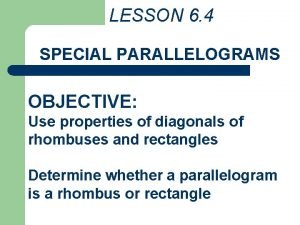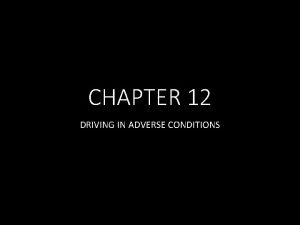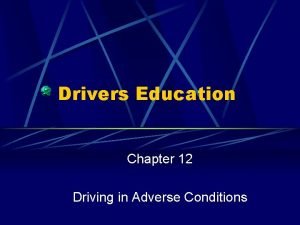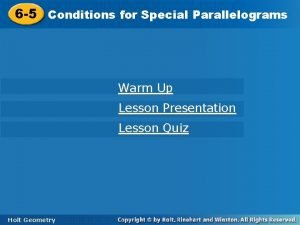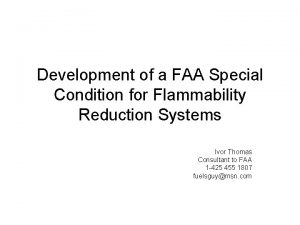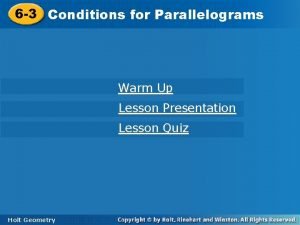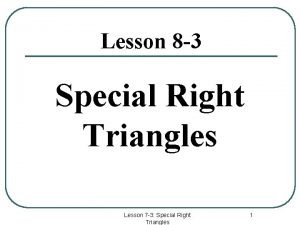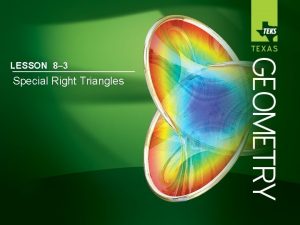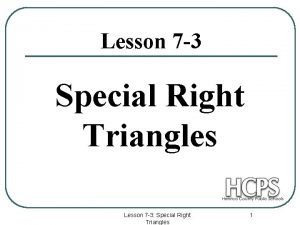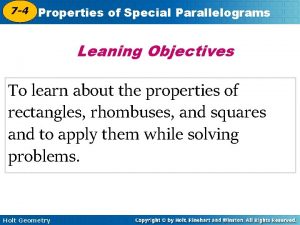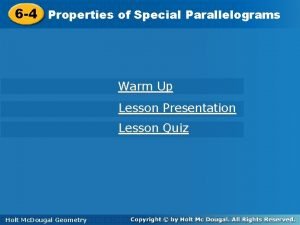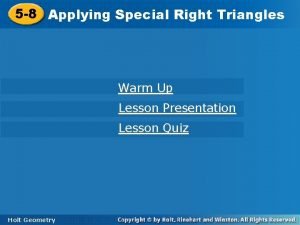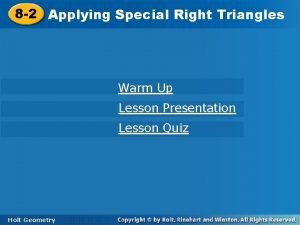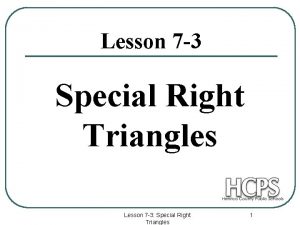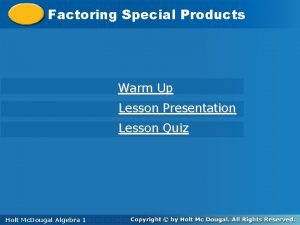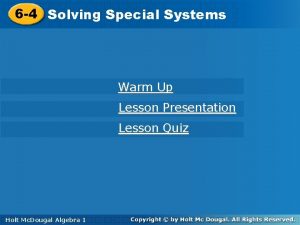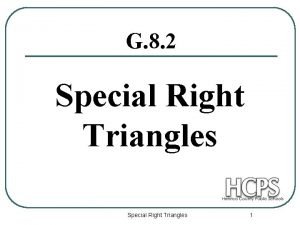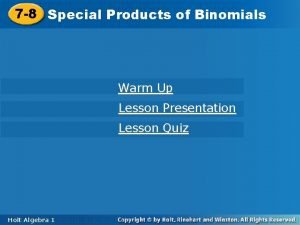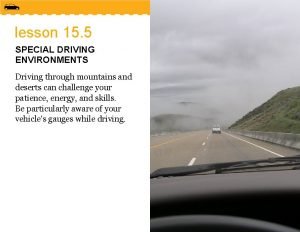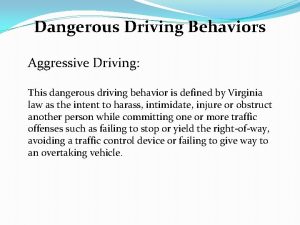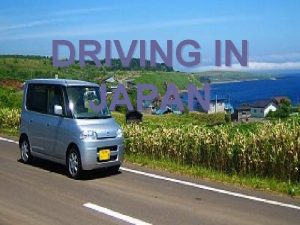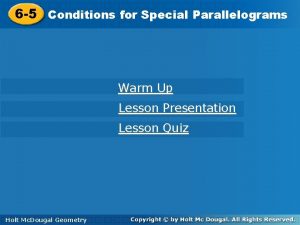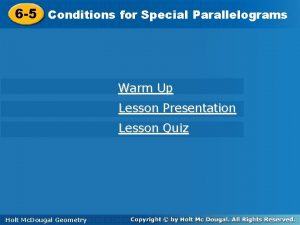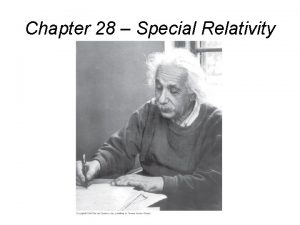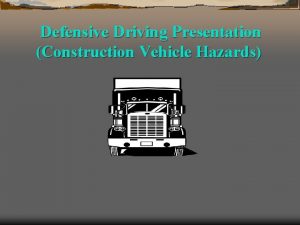SPECIAL DRIVING CONDITIONS Special Driving Conditions Lesson 1


































- Slides: 34

SPECIAL DRIVING CONDITIONS

Special Driving Conditions: Lesson 1 ADVERSE WEATHER

Adverse Weather • Drivers should review the weather forecast before each day’s trip – Expectation is less stressful than surprise • Notify dispatch of concerns so they can monitor for you • Do not try to maintain schedule; maintain safety

Hazards of Adverse Weather Rain, Snow, Ice, Fog, Smoke, Sleet, Hail Haze Reduced Visibility ✔ Reduced Control, Possible Skidding ✔ Increased Stopping Distance ✔ Congested Traffic ✔ ✔ Wind, Dust ✔ ✔

Reacting to Rain, Snow and Ice Action Speed Details/Reasons Reduce 15 -60% to More traction affected, greater the compensate for increased reduction stopping distance Following Distance Increase 1 -3 seconds Compensate for reduced visibility and/or traction; Rain-1 sec. ; Snow-2 sec. ; Ice-3 sec. Focus Observe traffic ahead of you closely Vehicle slowing or losing control ahead may indicate road hazard or become one Yes – Low beam Be visible to others; High beams can reflect off precipitation or surfaces, making it harder to see Lights On

Reacting to Rain, Snow and Ice Action Details/Reasons Wipers & Defroster Turn on defroster early – Turn on defroster with fogged windshields can sneak wipers up on you & can be hard to recover once fogged up Vehicle Steering & Control Gentle movements; gradual speed and direction changes Abrupt movements more likely to result in loss of control, especially in snow and ice Use in Snow and Ice May be required in certain areas; use as necessary otherwise Tire Chains/Socks

Reacting to Fog, Haze, Dust and Wind • Turn low beams on so others can see you • Reduce speed according to visibility restriction – Maintain appropriate sight interval Sight Interval Guidance 20 mph and below: minimum 3 seconds Above 20 mph: +1 second for every 10 mph

Learning From History February 14, 2003 Hewitt, TX

Learning From History 34 passengers 31 injured 7 killed

Learning from History e s u a C Probable • Limited sight distance due to weather conditions and roadway geometry • Wet roadway/reduced traction

Special Driving Conditions: Lesson 2 SPECIAL DRIVING SITUATIONS

Nighttime Driving • Vision at night limited – Environmental and physiological factors – Vision to sides (peripheral) suffers more than forward vision Detect hazards later = less time to respond Contrast

Maximizing Visibility • Use high beams where safe and legal • Avoid blinding other motorists – Both oncoming vehicles and those in front of you • Do not use 500 feet from an oncoming vehicle • Do not use when within 200 feet of a vehicle you are traveling behind • Avoid being blinded by others – Right lane use will limit exposure on highways; avoid looking directly at opposing headlights

Roadway Characteristics • Assess roadway – Lighting (more than your headlights? ) – Potential for hazards (controlled access? ) • Determine if speed reduction reasonable – Low lighting & open access • Beware of environmental noise masking hazards

Vehicle Condition Sight Components: • Lighting system – allows you to see and be seen – Check for function and cleanliness before trip – If operating in inclement weather, clean off headlamp, taillight and turn signal lenses at rest stops • Clean windshield and mirrors

Combating Fatigue Adjust your sleep/wake schedule beforehand if you will be driving through the night • Make frequent stops (10 mins every 2 -2. 5 hrs. ) – Physical activity/fresh air – Grab a coffee – No heavy meals/foods; No smoking • Bring sleep aids so you can get quality sleep during the day

Sun Glare • Can cause momentary blindness • Affects some drivers more than others • Slow down; use sun shades and sunglasses • Predictable; anticipate unusual traffic behaviors

Extreme Heat • Extreme heat can accelerate tire failure • Potential for tire failure under extreme heat conditions is enhanced when: – Tires are not (or have not been) inflated properly – Operating long distances at highway speeds – Coach is loaded with passengers and luggage Always evaluate tire inflation and distribute large luggage loads evenly

Retarder/Engine Brake CAUTION: DO NOT use a retarder while driving on wet, icy, or slippery roads, especially hills. Doing so can cause loss of control. • Various type of supplemental, non-friction based braking systems on commercial vehicles – Common terminology: retarder or ‘jake brake’ • Use prevents brake fade and wear & tear on service brake system • Driver-selectable settings (OFF, low, high, etc. )

Mountain Driving • Ensure engine coolant is at proper level • Check brake/air system for properation • Refrain from stopping on mountain inclines/declines unless unavoidable • Upgrade navigation: – Select/adjust to gear that allows you to maintain steady RPMs (manual)

Mountain Driving • Downgrade navigation: – Select gear appropriate for posted speed limit for CMVs – Set engine/transmission retarder on high * – Let retarder do the braking work unless speed gets above top end of desired range – If speed is not stable at/or below desired level, downshift one gear at a time until it maintains desired speed with retarder * See Retarder/Engine Brake info for details on when NOT to use the retarder

Mountain Driving - Braking Using service brakes – “snub method”: • Apply the brakes hard enough to feel a definite slowdown. • When speed has dropped to 5 mph below safe or intended speed, release the brakes. • When speed increases above the safe or posted speed, repeat the first two steps.

Runaway/Escape Ramps: – Sand and/or gravel – Usually uphill • Runaway vehicle sinks into sand/gravel while gravity slows the uphill vehicle

Skid Dynamics Skid = forces applied exceed friction/grip Skid Type Description Forces generated by the drive axle at the Acceleration wheels exceed the available tire/road friction – tires spin/slip against roadway Forces generated by braking force exceed the available tire/road friction – tires slide along Braking roadway Side forces generated during cornering exceed the tire/road friction – tires slide along Turning roadway

Skid Prevention • Reduce speed/take precaution when roadway clues indicate potential traction issues Onset of rain, snow, sleet Ice on mirrors, road signs, etc. Reduced Friction Clues Traffic around you is beginning to go slower Vehicles sliding on the road Vehicles pulling off the road onto the shoulder Wet looking road with little or no spray from vehicle wheels around you

Skid Recovery Skid Type Description Acceleration Drive wheels spinning during acceleration. Let off of accelerator until regain control. Apply throttle more gently. Braking Let off service brake and Wheels locked during stab brake to allow front braking; vehicle sliding. wheels to rotate and Possibly no steering regain steering control. while slowing down * If your drive wheels lock up and you are not using the brake, turn off engine/transmission brake

Skid Recovery Skid Type Turning Description Action Rear wheels lose traction while negotiating turn. Ease up on accelerator. Countersteer briefly toward slide. All wheels lose traction. Firm application if equipped with ABS; stab brake if no ABS system.

Learning From History December 21, 1999 Canon City, CO

Learning From History 57 passengers 3 killed 54 injured; 33 serious

Learning from History e s u a C Probable • Driver’s failure to control the motorcoach on the icy roadway • Crash sequence initiated by inappropriate decision to use the retarder under icy conditions

Hydroplaning • Tires cannot disperse the amount of water on the roadway necessary to maintain traction • Occurs when large amount of standing water or runoff on roadway, combined with excessive speed • Avoid by slowing down and avoiding standing or deep water

Work Zone Safety • Stay alert – Never drive distracted – Watch traffic in front for slowing and around you for motorists try to pass or ‘jump in line’ • Obey work zone signage and flaggers • Merge into proper lane early • Obey posted speed limit – Slow down if active zone has workers present • Don’t tailgate – despite the congestion

Work Zone Safety • Turn on headlights so workers and other motorists see you • Beware of narrow lanes and limited shoulders • Be prepared for rough road surfaces that can affect your driving • Avoid lane changes • Be patient!

Multi-Coach Convoys • Obey company policies and protocols • Maintain safe following distances • Know the complete itinerary, including intermediate stops and the routes – Do NOT be reliant on following other/lead coaches Special Note for Sports Team Convoys Many college team convoys are accompanied by police escorts who often want to maintain a ‘tight’ convoy. Remember, it’s ultimately your call on how to drive the coach.
 Special driving conditions
Special driving conditions Lesson 6-4 properties of special parallelograms
Lesson 6-4 properties of special parallelograms 6-5 conditions for special parallelograms answers
6-5 conditions for special parallelograms answers If you are driving under adverse conditions
If you are driving under adverse conditions Chapter 12 driving in adverse conditions
Chapter 12 driving in adverse conditions When your headlights shine into fog,
When your headlights shine into fog, Driving in adverse conditions
Driving in adverse conditions 6-5 conditions for special parallelograms answer key
6-5 conditions for special parallelograms answer key Faa special conditions
Faa special conditions Conditions for rhombuses rectangles and squares
Conditions for rhombuses rectangles and squares 6-3 conditions for parallelograms
6-3 conditions for parallelograms 3 special triangles
3 special triangles 8-3 special right triangles answers
8-3 special right triangles answers Practice 7-3 special right triangles worksheet answers
Practice 7-3 special right triangles worksheet answers 6-4 special parallelograms
6-4 special parallelograms 6-4 special parallelograms rectangles
6-4 special parallelograms rectangles 5-8 applying special right triangles answer key practice a
5-8 applying special right triangles answer key practice a Special right triangles simplest radical form
Special right triangles simplest radical form Unit 3 lesson 2 special right triangles
Unit 3 lesson 2 special right triangles Special right triangles radians
Special right triangles radians Unit 3 lesson 7 factoring special cases
Unit 3 lesson 7 factoring special cases Special right triangles
Special right triangles Lesson 26-2 factoring special products
Lesson 26-2 factoring special products Lesson 6-4 solving special systems answer key
Lesson 6-4 solving special systems answer key Special right triangles
Special right triangles Special lesson 3slg
Special lesson 3slg 7-8 special products of binomials
7-8 special products of binomials Multiplying special cases
Multiplying special cases Lesson outline lesson 3 describing circuits answers
Lesson outline lesson 3 describing circuits answers Kind of fault
Kind of fault Lesson outline lesson 2 aquatic ecosystems answer key
Lesson outline lesson 2 aquatic ecosystems answer key Micro-teaching lesson plan
Micro-teaching lesson plan Ihi leadership alliance
Ihi leadership alliance Where did ravi hide the kitten
Where did ravi hide the kitten Chapter 1 lesson 1 your total health answer key
Chapter 1 lesson 1 your total health answer key

